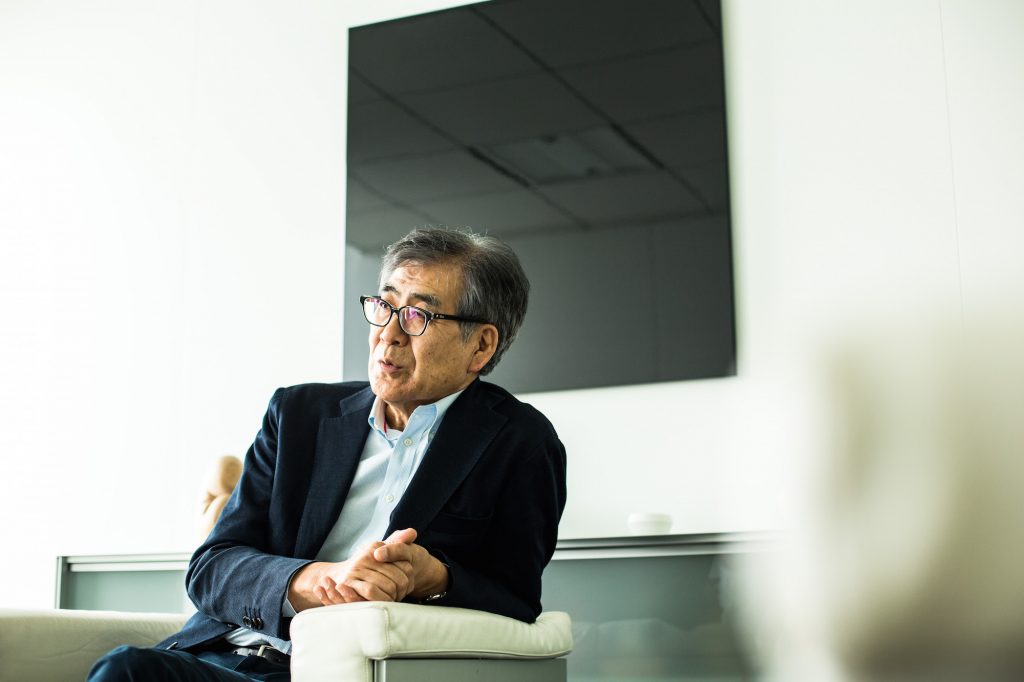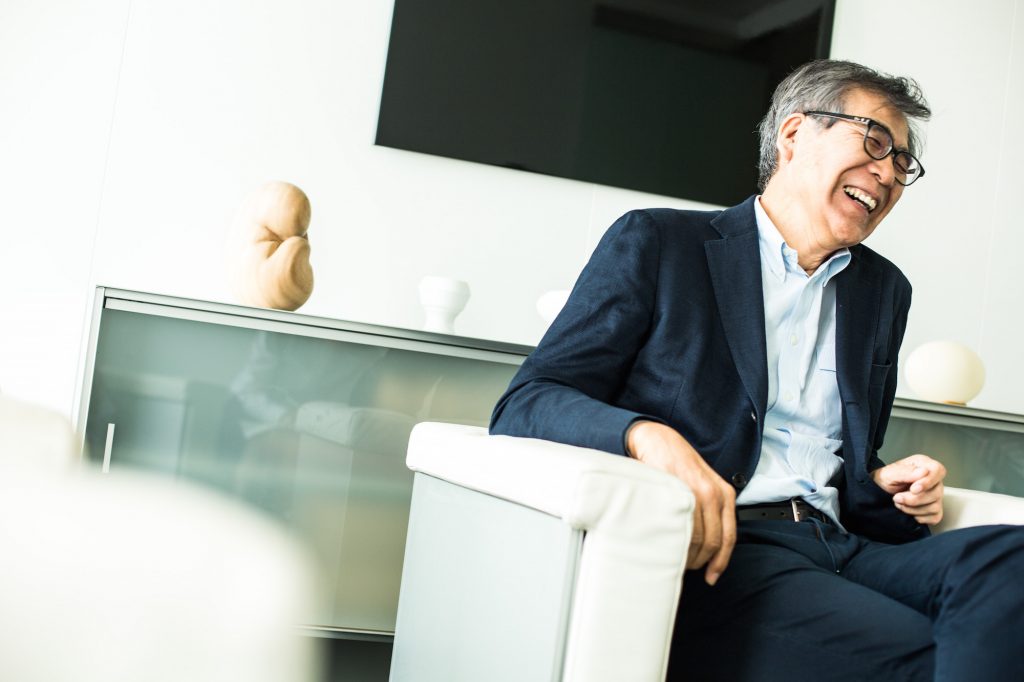Living in Space and the Evolution of AI. The Greater Impact of Culture on Cities of the Future.
ICF Committee Interview – Fumio Nanjo
Living in Space and the Evolution of AI. The Greater Impact of Culture on Cities of the Future.
LIVING IN THE EXTREME CONDITIONS OF OUTER SPACE FORCES US TO REEXAMINE THE REQUIREMENTS FOR HUMAN LIFE.
I will once again be moderating two sessions at this year’s Innovative City Forum. Either of them promises to be abounding with creativity and offer glimpses into the future. One of the sessions will be focused on the notion of how humans might live in space. This coincides with similar themes running through the current exhibition at Mori Art Museum entitled “The Universe and Art.” Earth’s environmental challenges have long been a topic of discussion, but when we think about the fate of our environment, outer space may serve as a useful reference point because of the extreme circumstances it represents.
It goes without saying that the earthly environment in which we have lived thus far is the most comfortable for us humans. Accordingly, when we venture into space, we are required to bring that earthly environment along with us. A surprising number of people are actually looking at space architecture from that very perspective. This year, ICF will welcome from among those people, Masayuki Sono of New York-based Clouds Architecture Office (Clouds AO) and Melodie Yashar of Space Exploration Architecture (SEArch). The “Mars Ice House” designed by Clouds AO and SEArch received first place in a design competition sponsored by NASA for designing a habitat where astronauts could live on Mars for one year. Observing the recently-discovered existence of water on Mars, their dwelling is constructed of ice, and in addition to a living space, includes a garden and other features reminiscent of Earth. A cluster of such structures could also be erected to form a city. I believe such efforts to preserve our earthly environment even in the severe conditions of outer space may offer keys to what we must consider when building cities here on Earth going forward.
This session will also include Zach Denfeld, co-founder of the Center for Genomic Gastronomy, and contemporary artist Tom Sachs, known for his space-themed sculpture project, A Space Program. A quick search will lead to the discovery that a considerable number of contemporary art works tackle the topic of outer space. This is undoubtedly in part because outer space is a place of endless possibilities.

A TRUE “INTERNATIONAL” CULTURE BORN OF SPACE-BOUND LIVING
At this very moment, the International Space Station is home to astronauts from several different countries cohabitating. As the number of inhabitants of space increase, it is only natural that people with differing customs and rules of conduct will end up living together. This is bound to create a demand for laws—as well as ethics and philosophy—specifically for space. And is it not possible that before long a new culture could be born out of this new environment? The result will perhaps be something that we could call a truly international culture.
With an eye on the future of culture in space, JAXA is conducting the ongoing experiment of making matcha green tea as the Japanese tea ceremony on the space station, while practicing “Earth viewing” instead of the traditional “moon viewing”. Because of the weightless environment, the matcha is made by putting it into a spherical glass, stirring it with a stick inserted from the top, and drinking it through a straw. From the sound of it, aesthetic perspectives, as well as the practice itself may be changing.
Space inhabitation will have a direct impact on the future of humanity and of our planet, so this is sure to be a very fascinating session.

KEEPING THE CULTURAL HERITAGE OF ASIA ALIVE.
I will also be moderating a session that will discuss how we can best take advantage of our cities as cultural assets.
While Europe began a long time ago leveraging its historical and cultural heritage as tourist attractions, efforts have been on the rise in many regional cities in Japan following the examples of Kyoto, Nara, and other cities to revitalize local communities by taking good advantage of their diverse cultural heritages. Attempts are also being made in various regions in Asia to preserve historical city blocks and traditional skills. This time, hoping to share those attempts for once, I plan to ask Ang Ming Chee of George Town World Heritage Incorporated in Malaysia, Vietnamese architect Vo Trong Nghia, and artist Yukinori Yanagi about their initiatives.
I look forward to revitalizing discussions on how to not simply “save” the many cultural and historical assets in Japan’s regional cities, but how to “make the most” of them. If we are preoccupied by mere preservation, it may just end up being an expensive endeavor, without anyone being able to actually use these assets. That will not bring happiness to anyone involved. I also believe it is important to create a space that can be effectively used for a long time, even if its use is different from the site’s original purpose.

DEVELOPMENT OF CULTURE HOLDS THE KEY TO FUTURE OF HUMANITY.
One of our major motivations for starting Innovative City Forum was the idea that Japan— especially Tokyo—should become a center for creative industry in the future. That is why we consider it essential that continuing to hold forums like ICF contributes to Tokyo being thought of as a center of creativity in Asia.
Including art as an element of a forum addressing the future of cities is uncommon, but these ideas are represented in it as well. Artificial intelligence, one of the major themes of this ICF, has begun to spark discussions about how its growth may lead human ability to survive without working. How will humans use our time when we no longer have to work to live? Without a doubt, culture and sports will occupy principal positions in our lives.
When I think about this prospect, I recall the 300 years of unbroken peace in old Tokyo (Edo). People in the Edo Period (1603-1868) did not overly devote themselves to labor, but rather immersed themselves in composing epic songs or haiku, playing the koto or shamisen. If there were a utopian society, it may look quite similar to that.
Economic activity chasing after endless rapid growth. Competing for GDP rankings. Scrambling for energy resources… To rid ourselves of such a value system, we will have to think about wealth that is brought about by culture. I believe that what we should aim at is not the accumulation of wealth, but rather the development and democratization of culture. This year’s ICF welcomes people from a wide range of fields bringing together their respective knowledge, and it is sure to reveal a glimpse of our future.

Fumio Nanjo
Mori Art Museum Director
Nanjo graduated from Keio University with a degree in Aesthetics and Art History. He has worked for the Japan Foundation (1978-1986), and became Deputy Director of Mori Art Museum in 2002 until taking his current position in November 2006. In the past, he has served as commissioner of the Japan Pavilion at the Venice Biennale (1997), and the Taipei Biennale (1998); jury member of the Turner Prize at the Tate Gallery (London, 1998); artistic co-director of the Yokohama Triennale (2001); and artistic director of the Singapore Biennale (2006, 2008). His recent publications include Sprinting Asia: Looking at the State of Contemporary Art (Art Annual, 2010) and Live Art (Kadokawa Shoten, 2012).

